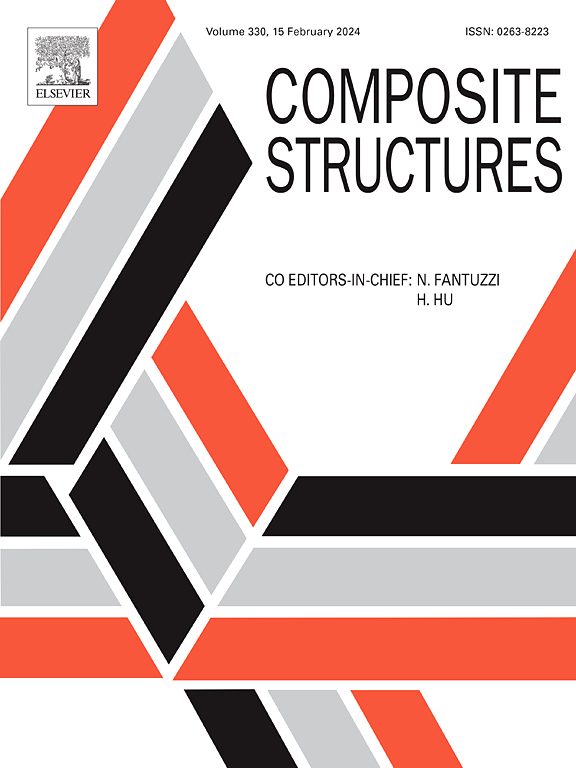An analytical approach to predicting tensile pseudo-ductility and multi-stage failure process of multidirectional thin-ply CFRP laminates
IF 6.3
2区 材料科学
Q1 MATERIALS SCIENCE, COMPOSITES
引用次数: 0
Abstract
This paper presents an analytical model for predicting the nonlinear tensile response and progressive failure modes of multidirectional laminates. The proposed method extends the unidirectional pseudo-ductility model to multidirectional laminates and captures the complete failure process by taking accounts of various failure modes, including fiber breakage, matrix transverse failure, free-edge delamination, and potential intermediate layer fragmentation and delamination. Combining the matrix nonlinearity with fiber fracture and delamination in the intermediate layer, the [±θn/0°m/±θn] configuration theoretically exhibits the highest uniaxial tensile pseudo-ductility, which is influenced by factors such as ply thickness, ply angle, and proportion of plies. Tensile testing on specimens with various thin-ply [±θn/0°2/±θn] configurations were conducted to validate the accuracy of the prediction model. The results showed a good agreement in the stress–strain responses. Furthermore, the [±30°6/0°2/±30°6] configuration exhibited intermediate ply fragmentation with a pseudo-ductile strain of 4.04 %, while other configurations with higher 0° ply proportions experienced catastrophic delamination or fracture. The Digital Image Correlation (DIC) results illustrated the strain evolution process, showing progressive delamination for the [±30°6/0°2/±30°6] configuration and catastrophic delamination for the [±30°4/0°2/±30°4] configuration. The analytical approach offers a straightforward method for capturing failure modes and stress–strain responses, facilitating pseudo-ductility design in multidirectional laminates.

多向CFRP薄板拉伸拟延性及多阶段破坏过程的分析预测方法
本文提出了一种预测多向层合板非线性拉伸响应和渐进破坏模式的解析模型。该方法将单向伪延性模型扩展到多向层合板,并考虑了纤维断裂、基体横向破坏、自由边缘分层以及潜在中间层破碎和分层等多种破坏模式,捕捉了多层层合板的完整破坏过程。结合基体非线性、纤维断裂和中间层脱层,[±θn/0°m/±θn]结构在理论上表现出最高的单轴拉伸伪延性,其受层厚、层角和层数比例等因素的影响。为验证预测模型的准确性,对不同薄层[±θn/0°2/±θn]结构的试件进行了拉伸试验。结果表明,应力-应变响应具有较好的一致性。此外,[±30°6/0°2/±30°6]配置表现出中等厚度的断裂,伪韧性应变为4.04%,而其他具有较高0°厚度比例的配置则发生灾难性的分层或断裂。数字图像相关(DIC)结果显示了应变演化过程,显示了[±30°6/0°2/±30°6]结构的渐进分层和[±30°4/0°2/±30°4]结构的灾难性分层。分析方法为捕获破坏模式和应力应变响应提供了一种简单的方法,有助于多向层合板的拟延性设计。
本文章由计算机程序翻译,如有差异,请以英文原文为准。
求助全文
约1分钟内获得全文
求助全文
来源期刊

Composite Structures
工程技术-材料科学:复合
CiteScore
12.00
自引率
12.70%
发文量
1246
审稿时长
78 days
期刊介绍:
The past few decades have seen outstanding advances in the use of composite materials in structural applications. There can be little doubt that, within engineering circles, composites have revolutionised traditional design concepts and made possible an unparalleled range of new and exciting possibilities as viable materials for construction. Composite Structures, an International Journal, disseminates knowledge between users, manufacturers, designers and researchers involved in structures or structural components manufactured using composite materials.
The journal publishes papers which contribute to knowledge in the use of composite materials in engineering structures. Papers deal with design, research and development studies, experimental investigations, theoretical analysis and fabrication techniques relevant to the application of composites in load-bearing components for assemblies, ranging from individual components such as plates and shells to complete composite structures.
 求助内容:
求助内容: 应助结果提醒方式:
应助结果提醒方式:


